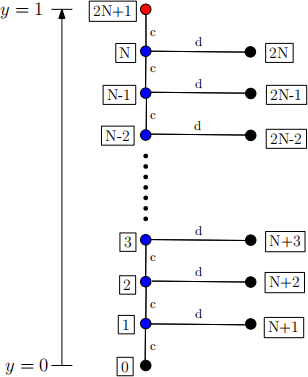M40007: Introduction to Applied Mathematics Coursework 2 (2023)
Hello, dear friend, you can consult us at any time if you have any questions, add WeChat: daixieit
M40007: Introduction to Applied Mathematics
Coursework 2 (2023)
Note 1: You must explain all your calculations clearly to get full credit.
Note 2: This assessment will be graded out of 40 marks. 90% of the grade for this coursework (36/40) will be assigned for a correct, well-argued calculation. Another 10% (4/40) will be awarded at the grader’s discretion for clarity and presentation of your solution.
Note 3: Due by midday on Monday March 13th 2023. Please submit via the Turnitin dropbox link provided in Blackboard.
Part I: For any integer n > 0 define

(i) Calculate these two integrals explicitly.
(ii) Use the result of part (i) to find the Fourier sine series of both sinh y and cosh y over the interval [0, 1[ (you should use ideas from the “Calculus and Applications” course).
Part II: Consider the electric circuit shown in the Figure where the vertical edges have conductance c and the horizontal edges have conductance d. Node
|
0 |
![]()
![]()
![]()
![]()
![]() at nodes
at nodes ![]() 1
1 ![]() to . The nodes should be ordered as follows: , . . . , ,
to . The nodes should be ordered as follows: , . . . , ,
![]() 0
0 ![]() ,
, ![]() 2N+1
2N+1 ![]() .
.
(a) Show that the conductance-weighted Laplacian matrix is

where Ij denotes the j-by-j identity matrix and KN is the N-by-N matrix fa- miliar from lectures. You should find the N-by-2 matrix P.
(b) Let【πj1j = 1, . . . , N} and【入j1j = 1, . . . , N} denote the orthonormal eigenvec- tors and corresponding eigenvalues of KN . By writing

find the coefficients【aj(入)1j = 1, . . . , N}.

(c) Show that the n-th element of ![]() can also be written as
can also be written as

for suitable choices of the parameters 入士(入).
(d) The uniqueness theorem for harmonic potentials discussed in lectures has an analogous version when the conductances are not all equal. Use this fact to establish a discrete identity involving your answers to parts (b) and (c).
(e) Now pick 入 to be given by

and introduce the new variable

Find the limit of both left- and right-hand sides of the discrete identity you found in part (d) as N → 否 with y taken to be fixed.
2023-03-15